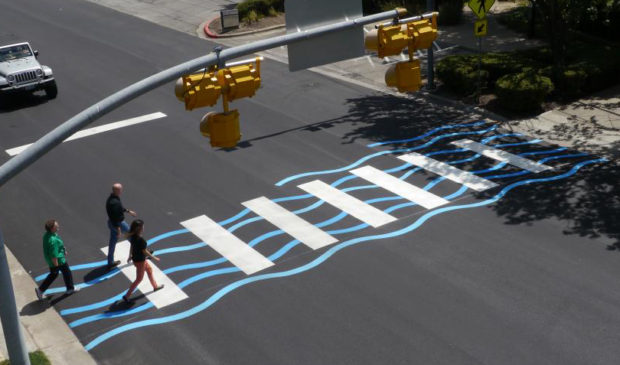ASMP caught between pedestrian safety and need for speed
Friday, March 8, 2019 by
Ryan Thornton The city is promoting an everyone-wins approach to mobility in which maintaining, expanding and even adding car lanes is considered compatible with dramatically increasing use of other transportation modes per capita and cutting the number of annual traffic deaths and serious injuries to zero by 2025.
Following a presentation on the Austin Strategic Mobility Plan with the assistant director of Austin Transportation, Annick Beaudet, Monday evening, the Pedestrian Advisory Council raised a number of concerns about that approach, suggesting those goals may be mutually exclusive.
The central target driving ASMP is to reach an equal mode share split between those who drive alone to work and those who telework or commute via a different mode by 2039. While acknowledging the clear need to reach that 50/50 goal, PAC approved a list of recommendations to City Council to simultaneously ensure that the urgent need for safe pedestrian infrastructure across the city is not lost in a numbers game.
Beaudet said reaching that mode share split will likely require a strong focus on making improvements to pedestrian-friendly areas around the University of Texas and downtown. However, alternate member Tom Wald stressed that having only a few highly walkable neighborhoods in the city core should not be the long-term goal.
“There’s kind of this general assumption in the public mind that pedestrian areas are closer to downtown and that once you get further out, pedestrian friendliness is not as important, but I don’t think that should be the case,” Wald said.
Wald’s comment was part of a larger discussion about the placement of high-speed roadways not owned by the Texas Department of Transportation within the city limits. PAC Chair Jay Blazek Crossley said speeds above 35 mph should have no place anywhere in pedestrian areas, per the National Association of City Transportation Officials guidelines.
Taking the Austin Street Design Guide as its basis, ASMP would permit a number of urban and suburban streets to reach up to 45 mph. As Crossley mentioned, these include many roads, like sections of North Lamar Boulevard, with abundant pedestrian activity.
Additionally, PAC member Branigan Mulcahy pointed out that planning such projects based on current pedestrian activity ignores the reality of latent demand, which proposes that unfavorable or dangerous conditions make demand for pedestrian infrastructure appear smaller than it is.
PAC member Adam Greenfield also objected to what he considered a counterproductive plan in the ASMP street network table to induce car use by building new roads. In specific reference to Maha Loop Road, a new roadway project in East Austin that would install a four-lane road where currently there is none, Greenfield said any part of the city with enough traffic to take up four traffic lanes would be an ideal place to expand transit service instead of further promoting car use.
Beaudet said all of the road designs were developed according to the department’s best technical recommendations and could be changed in the future. “The approach was improving the grid as we got further and further out from the urban core where there’s a lot of disconnected streets,” she said. “In those places we looked at the functionality of what that street was and then the street design guide has a recommendation on how it should be built.”
With the ASMP timeline stretching to 2039, Crossley also stressed that the city’s Sidewalk Master Plan has its own target of funding and constructing 390 miles of sidewalks by 2026. ASMP action item 65 states the goal of constructing all sidewalks according to the sidewalk plan, but Crossley noted that the plan only covers high-priority sidewalks. At his suggestion, PAC recommended City Council amend ASMP to include a plan for medium- and low-priority sidewalks as well.
Crossley also recommended the city put a three-year deadline on ASMP action item 69, related to the enforcement of clearing sidewalks of obstructions like the city’s beloved agave plants or parked cars.
Having already given the same pitch to the Mobility Committee on Feb. 28, transportation researcher Katie Kam convinced PAC to add language to its recommendation regarding what she said is a promising mode of urban transportation called neighborhood electric vehicles, already in use by the University of Texas and the city of Austin.
Though Crossley hesitated to endorse infrastructure for vehicles of any kind when the need for sidewalks is still a major issue, Wald agreed with Kam that ASMP should at least mention NEVs as well as pedicabs since they are both lighter and slower alternatives to cars.
The recommendation passed 6-0 with members Mark Wochner and Justin Henderson and alternate member Anna Bauereis absent.
Photo courtesy of the city of Austin.
The Austin Monitor’s work is made possible by donations from the community. Though our reporting covers donors from time to time, we are careful to keep business and editorial efforts separate while maintaining transparency. A complete list of donors is available here, and our code of ethics is explained here.
You're a community leader
And we’re honored you look to us for serious, in-depth news. You know a strong community needs local and dedicated watchdog reporting. We’re here for you and that won’t change. Now will you take the powerful next step and support our nonprofit news organization?










